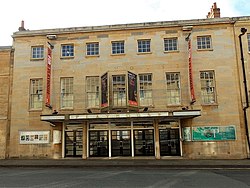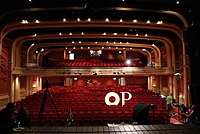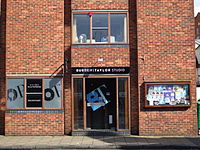Difference between revisions of "Oxford Playhouse"
(No difference)
| |
Latest revision as of 13:57, 21 March 2024
| Oxford Playhouse | |
|
Oxfordshire | |
|---|---|
 The Oxford Playhouse on Beaumont Street | |
| Type: | Theatre |
| Location | |
| Grid reference: | SP51120649 |
| Location: | 51°45’17"N, 1°15’39"W |
| City: | Oxford |
| History | |
| Built 1938 | |
| By: | Edward Maufe (exterior) F. G. M. Chancellor (interior) |
| Theatre | |
| Information | |
| Website: | oxfordplayhouse.com |
Oxford Playhouse is a theatre on Beaumont Street in Oxford, Oxfordshire, opposite the Ashmolean Museum. The playhouse designed by Edward Maufe and F.G.M. Chancellor. It is a Grade II* listed building.[1]
History
The Playhouse was founded as The Red Barn at 12 Woodstock Road in the north of Oxford, in 1923 by J.B. Fagan.[2] The early history of the theatre is documented by the theatre director, Norman Marshall in his 1947 book, The Other Theatre.[3] Don Chapman also provided a comprehensive study of the theatre in the 2008 book, Oxford Playhouse: High and Low Drama in a University City.[4]
The exterior design of the theatre building on the south side of Beaumont Street was by Sir Edward Maufe, with the interior design by F.G.M. Chancellor;[5] the building was completed in 1938.[6] It is faced with stone, in keeping with the early 19th century Regency buildings in the street.
Many famous, international names The Oxford Playhouse was the base from which Prospect Theatre Company was created by manager Elizabeth Sweeting and resident stage manager Iain Mackintosh in 1961. Between 1963 and 1976, the Prospect Theatre Company toured 75 productions to 125 theatres in 21 countries.
The Greek theatre director Minos Volanakis was an associate director at the Playhouse; his productions included Jean Genet's The Maids (1963–4) and The Balcony (1967), and Jean Giraudoux's Madwoman of Chaillot.[7]
The freehold of the building is owned by St John's College.[8]
Burton Taylor Studio
Oxford Playhouse has close relations with the University of Oxford and is the home stage of the Oxford University Dramatic Society. On behalf of the university the Playhouse also manages the nearby Burton Taylor Studio, named in honour of Richard Burton and Elizabeth Taylor. "The BT" is a 50-seat studio theatre in Gloucester Street, close to the Oxford Playhouse. It originated in 1966, when Richard Burton donated money towards the creation of a rehearsal space, also occasionally used for performance, named the Burton Rooms.
A couple of decades later, students from the Oxford University Dramatic Society established the current tradition of the venue as a home for regular student productions.[9] The Burton Taylor Studio programmes a mix of student and professional productions throughout the year.[9]
Outside links
| ("Wikimedia Commons" has material about Oxford Playhouse) |
References
- ↑ National Heritage List 1185150: The Playhouse (Grade II* listing)
- ↑ "Oxford Playhouse". Oxfordshire Blue Plaques Scheme. http://oxonblueplaques.org.uk/plaques/oxford_playhouse.html.
- ↑ Marshall, Norman (1947). The Other Theatre. London: Lehmann J. Lehmann.
- ↑
- Chapman, Don (2008). Oxford Playhouse: High and Low Drama in a University City. Society for Theatre Research, University of Hertfordshire Press. ISBN 978-1-902806-86-0.
- "Behind the scenes at the Playhouse" (in en). Oxford Mail. 9 March 2009. https://www.oxfordmail.co.uk/news/4187251.behind-scenes-playhouse/.
- ↑ History of Oxford Playhouse, Oxford Playhouse website, accessed 24 January 2022.
- ↑ Nikolaus Pevsner: The Buildings of England: Oxfordshire, 1974 Penguin Books ISBN 978-0-300-09639-2page 324
- ↑ Chapman (2008, pages 184, 186, 196–197) and The New York Times obituary for Volanakis.
- ↑ "St John's College | Must see Oxford University Colleges | Things to See & do in Oxford". http://discoveroxfordshire.com/things-to-do/st-johns-college/.
- ↑ 9.0 9.1 "Oxford Playhouse: Burton Taylor Studio". Oxford Playhouse. http://www.oxfordplayhouse.com/aboutus/btstudio.aspx.
- Chapman, Don (2008). Oxford Playhouse: High and Low Drama in a University City. Society for Theatre Research, University of Hertfordshire Press. ISBN 978-1-902806-86-0.
- Marshall, Norman: 'The Other Theatre' (John Lehmann, 1947)

